Michael J. Behe's Blog, page 3
March 18, 2023
“Trust the Science!” Files: Prof punished for saying the obvious
At MercatorNet:
The most recent case occurred last month at Laval University in Canada, when professor and RNA expert Patrick Provost was suspended without pay for anti-mRNA vaccine comments. Patrick Provost has run an RNA lab for 20 years and has published nearly 100 peer-reviewed studies. In 2003, Provost’s work on the role of microRNA in gene expression was named one of the 10 discoveries of the year by the Quebec Science Magazine.
Based on the government’s own hospitalization and mortality statistics for children, which are both very low, Provost said he believed the risks of Covid-19 vaccination in children could outweigh the benefits because of the potential side-effects from mRNA vaccines, which have only gone through two of the usual four stages of testing required before vaccines are approved for general use.
“I was just doing what I was hired to do,” he said in an interview. “I had some concerns about something, I searched the literature and I prepared a talk and I delivered it to the public. Being censored for doing what I’ve been trained to do — and hired to do — well, it’s hard to believe.”
“As soon as you raise some concerns about vaccines, or side-effects, or complications related to vaccines, then it’s worse than the N-word,” he continued. “You’re condemned by the media, by the government and you’re chased and put down …. We should be able to discuss any ideas — any opinions — and because I expressed opinions that went against the government narrative, I was suspended.”
Regarding the University’s reaction, one might well wonder about the fact that the top 20 pharmaceutical companies spent C$139 billion on Research & Development in 2022, a portion of which went to university researchers. Faculties of medicine are particularly favoured beneficiaries of such funding. And Patrick Provost is a professor at the Faculty of Medicine. – Patrick Duffley (March 16, 2023)
“Science” is quickly becoming a monster whose greatest fear is everyday facts.
Copyright © 2023 Uncommon Descent . This Feed is for personal non-commercial use only. If you are not reading this material in your news aggregator, the site you are looking at is guilty of copyright infringement UNLESS EXPLICIT PERMISSION OTHERWISE HAS BEEN GIVEN. Please contact legal@uncommondescent.com so we can take legal action immediately.Plugin by Taragana
March 17, 2023
Peer reviewed paper calls for changes to Darwinism
A peer-reviewed paper published towards the end of last year in the Elsevier journal Progress in Biophysics and Molecular Biology has a provocative title: “Neo-Darwinism Must Mutate to Survive.” …
“Realistic probability calculations based on probabilities associated with microevolution are presented. However, macroevolution (required for all speciation events and the complexifications appearing in the Cambrian explosion) are shown to be probabilistically highly implausible (on the order of 10-50) when based on selection by survival of the fittest. We conclude that macroevolution via survival of the fittest is not salvageable by arguments for random genetic drift and other proposed mechanisms. [– from the paper] ” – Casey Luskin (March 15, 2023)
Much more at the link. The paper requires a fee or subscription.
And wow. Careers used to die over statements like that.
Look, evidence has nothing whatever to do with it. The researchers can have boatloads of evidence and scrupulous methods for handling it.
BUT if conclusions that cast doubt on settled, easy Darwinism are allowed to just be published and stay published, with no one punished – think of the huge swathes of sloppy Darwinian claims in the literature that could suddenly become subject to actual scrutiny… Omigosh… it would start to look like actual science…
Well, if Brown and Hullender survive, stay tuned. Here’s their abstract:
Copyright © 2023 Uncommon Descent . This Feed is for personal non-commercial use only. If you are not reading this material in your news aggregator, the site you are looking at is guilty of copyright infringement UNLESS EXPLICIT PERMISSION OTHERWISE HAS BEEN GIVEN. Please contact legal@uncommondescent.com so we can take legal action immediately.Darwinian evolution is a nineteenth century descriptive concept that itself has evolved. Selection by survival of the fittest was a captivating idea. Microevolution was biologically and empirically verified by discovery of mutations. There has been limited progress to the modern synthesis. The central focus of this perspective is to provide evidence to document that selection based on survival of the fittest is insufficient for other than microevolution. Realistic probability calculations based on probabilities associated with microevolution are presented. However, macroevolution (required for all speciation events and the complexifications appearing in the Cambrian explosion) are shown to be probabilistically highly implausible (on the order of 10−50) when based on selection by survival of the fittest. We conclude that macroevolution via survival of the fittest is not salvageable by arguments for random genetic drift and other proposed mechanisms. Evolutionary biology is relevant to cancer mechanisms with significance beyond academics. We challenge evolutionary biology to advance boldly beyond the inadequacies of the modern synthesis toward a unifying theory modeled after the Grand Unified Theory in physics. This should include the possibility of a fifth force in nature. Mathematics should be rigorously applied to current and future evolutionary empirical discoveries. We present justification that molecular biology and biochemistry must evolve to aeon (life) chemistry that acknowledges the uniqueness of enzymes for life. To evolve, biological evolution must face the known deficiencies, especially the limitations of the concept survival of the fittest, and seek solutions in Eigen’s concept of self-organization, Schrödinger’s negentropy, and novel approaches.
Plugin by Taragana
Bioelectric code gains new recognition as body organizer and form of intelligence

Here’s a new book on the topic (Hachette 2023):
I’ve written about the “electric cell” here and here, describing how electric currents in cell membranes transmit information through an “electric code.” I’ve also written about “water wires” and cable bacteria. Biologists have long known about the membrane potential of an individual cell, which measures about -70 millivolts, due to ionic separations. They have known that neurons transmit ionic voltages down their membranes. Now, recent discoveries are showing that we must expand our exploration of bioelectricity to the whole body. – David Coppedge (March 15, 2023)
Bioelectricity vs DNA – what they do:
“We would call this intelligence.”
Also:
Collective Intelligence in Unconventional Spaces with Michael Levin:
Copyright © 2023 Uncommon Descent . This Feed is for personal non-commercial use only. If you are not reading this material in your news aggregator, the site you are looking at is guilty of copyright infringement UNLESS EXPLICIT PERMISSION OTHERWISE HAS BEEN GIVEN. Please contact legal@uncommondescent.com so we can take legal action immediately.Plugin by Taragana
The “starseeds” among us: In case we thought reason was going to get a fair shake out of all this “science” stuff…
Star people, or starseeds, are individuals who believe they have come to Earth from other dimensions to help heal the planet and guide humanity into the “golden age” – a period of great happiness, prosperity, and achievement.
It might sound a little crazy but an internet search for the term brings up over 4 million results and there are scores of people posting videos on TikTok, Instagram, and Facebook who believe they originate from another world. Indeed, content with the term #starseed has over 1 billion views on TikTok.
Unlike “Earth souls”, who are said to reincarnate on Earth, starseeds believe they have reawakened from another planet to be born here. Starseeds believe they are conduits between divine realms and the Earth and that they can transport between galaxies via meditation…
They are also said to be empathetic, sensitive, and have more physical and mental health issues as their souls aren’t used to having a human body. – Ken Drinkwater et al. (March 14, 2023)
Please. Just please. We believe it about the mental health issues though.
Here’s an academic source.
We wouldn’t care except:
In the case of starseeds, several books published by big publishing houses may provide a sense of authenticity and so too does the fact that a number of them are bestsellers. – Ken Drinkwater et al. (March 14, 2023)
One wonders, do these starseeds see any evidence for design in the universe? Or are they (and we) the ultimate expression of human biology as sheer, meaningless chaos?
Copyright © 2023 Uncommon Descent . This Feed is for personal non-commercial use only. If you are not reading this material in your news aggregator, the site you are looking at is guilty of copyright infringement UNLESS EXPLICIT PERMISSION OTHERWISE HAS BEEN GIVEN. Please contact legal@uncommondescent.com so we can take legal action immediately.Plugin by Taragana
And now for something completely different, from spider world: Brown widows kill black widows
At UPI:
Black widow spiders could face extinction in parts of the southern United States, as they become prey for the non-native brown widow, according to new research…
While black widows are known for their poisonous bite, they are not aggressive if unprovoked. In comparison, brown widows grow faster and are twice as fertile, producing more egg sacs than southern black widows.
Brown widows are also six times more likely to kill and consume “shy” southern black widows, according to researchers, than other cobweb spiders. – Sheri Walsh (March 14, 2023)
Cry. Weep and cry. Go ahead. We dare you.
No, but seriously, this is one situation where legitimate ecology concern is not helped by natural human emotion, as in the case of eagles, for example. Natural human emotion, in this case, is more along the lines of: Oh, why can’t they all just kill each other?
The paper is open access.
In a container habitat set up by USF researchers, brown widows were 6.6 times more likely to attack black widows than other related species. The behavior is likely a driver of the black widow spider’s population decline according to a new study.
Note: Pencilman!! appears because the alternative would be to go out and find anther black widow.
In case you wondered…
You may also wish to read: Spiders are smart. Be glad they are small. Recent research has shed light on the intriguing strategies that spiders use to deceive other spiders — and prey in general. Invertebrates like spiders and octopuses can be smarter than we used to think and we are only beginning to discover their many strategies.
and
In what ways are spiders intelligent? The ability to perform simple cognitive functions does not appear to depend on the vertebrate brain as such. Recent claims of data fabrication against Jonathan Pruitt shouldn’t detract from genuine new finds re spider intelligence.
Copyright © 2023 Uncommon Descent . This Feed is for personal non-commercial use only. If you are not reading this material in your news aggregator, the site you are looking at is guilty of copyright infringement UNLESS EXPLICIT PERMISSION OTHERWISE HAS BEEN GIVEN. Please contact legal@uncommondescent.com so we can take legal action immediately.Plugin by Taragana
Ichthyosaurs appeared suddenly
At Creation-Evolution Headlines:
Oldest sea reptile from Age of Dinosaurs found on Arctic island (Uppsala University, 14 March 2023). “For nearly 190 years, scientists have searched for the origins of ancient sea-going reptiles from the Age of Dinosaurs. Now a team of Swedish and Norwegian palaeontologists has discovered remains of the earliest known ichthyosaur or ‘fish-lizard’ on the remote Arctic island of Spitsbergen.” The press release uses six paragraphs to tell the usual evolutionary narrative. Then, the double surprise appears:
“Unexpectedly, these vertebrae occurred within rocks that were supposedly too old for ichthyosaurs. Also, rather than representing the textbook example of an amphibious ichthyosaur ancestor, the vertebrae are identical to those of geologically much younger larger-bodied ichthyosaurs…”
Surprised enough yet? There’s more:
“and even preserve internal bone microstructure showing adaptive hallmarks of fast growth, elevated metabolism and a fully oceanic lifestyle.”
There it is: an advanced ichthyosaur appearing fully formed in rocks “too old” for ichthyosaurs—rocks dated 250 million Darwin Years, a time right after the great Permian extinction.– David F. Coppedge (March 14, 2023)
But the Darwinian story is much easier to teach…
Here’s the original Uppsala U PR. The paper is open access.
Here’s the story as of nearly a year ago but with ichthyosaur graphics:
Copyright © 2023 Uncommon Descent . This Feed is for personal non-commercial use only. If you are not reading this material in your news aggregator, the site you are looking at is guilty of copyright infringement UNLESS EXPLICIT PERMISSION OTHERWISE HAS BEEN GIVEN. Please contact legal@uncommondescent.com so we can take legal action immediately.Plugin by Taragana
Bumblebees can learn from each other – but why not?
Who else are they going to learn from? At BigThink:
We know that chimpanzees are capable of social learning. They craft “probing” tools from twigs to fish tasty termites out of holes in logs, and teach their young to do the same. Moreover, some dolphins utilize and pass on a behavior called shelling, in which they chase fish into the empty shells of giant gastropods, then bring the shells to the surface where they drain out the water and shake the fish into their open mouths. (Didn’t their mothers ever teach them not to play with their food?)
While bumblebees of the species Bombus terrestris aren’t quite capable of those advanced eating techniques, a team of scientists hailing from various institutions in the United Kingdom did manage to teach a few brainy bees to solve a basic puzzle to attain a sugary reward. They then released these learned bumbles into their colonies, where, lo and behold, the behavior spread. – Ross Pomeroy (Marcy 7, 2023)
Setting aside the riff on “advanced eating techniques (insects have different eating parts in any event), the big takeaway here is that chimps and dolphins are not much smarter than bumblebees. Humans are still the Big Exception.
You may also wish to read: Spiders are smart. Be glad they are small. Recent research has shed light on the intriguing strategies that spiders use to deceive other spiders — and prey in general. Invertebrates like spiders and octopuses can be smarter than we used to think and we are only beginning to discover their many strategies.
and
In what ways are spiders intelligent? The ability to perform simple cognitive functions does not appear to depend on the vertebrate brain as such. Recent claims of data fabrication against Jonathan Pruitt shouldn’t detract from genuine new finds re spider intelligence.
Copyright © 2023 Uncommon Descent . This Feed is for personal non-commercial use only. If you are not reading this material in your news aggregator, the site you are looking at is guilty of copyright infringement UNLESS EXPLICIT PERMISSION OTHERWISE HAS BEEN GIVEN. Please contact legal@uncommondescent.com so we can take legal action immediately.Plugin by Taragana
March 16, 2023
L&FP, 66: String — yes, s-t-r-i-n-g — data structures as key information storage arrays (thus the significance of DNA and mRNA)
One of the more peculiar objections to the design inference is the strident, often repeated claim that the genetic code is not a code, and that DNA and mRNA are not storing algorithmic, coded information used in protein synthesis. These are tied to the string (yes, s-t-r-i-n-g) data structure, a key foundational array for information storage, transfer and application. So, it seems useful to address the string as a key first principles issue, with the onward point being that strings of course can and do store coded information.
Let us begin with, what a string — yes, s-t-r-i-n-g — is (though that should already be obvious from even the headline):
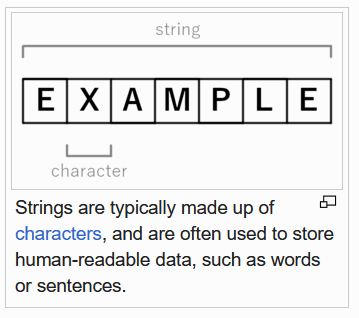 Wikipedia illustrates a string data structure
Wikipedia illustrates a string data structure
Geeks for Geeks: A string is a sequence of characters, often used to represent text. In programming, strings are a common data type and are used for a variety of tasks, such as representing names, addresses, and other types of information.
Wikipedia confesses: In computer programming, a string is traditionally a sequence of characters, either as a literal constant or as some kind of variable. The latter may allow its elements to be mutated and the length changed, or it may be fixed (after creation). A string is generally considered as a data type and is often implemented as an array data structure of bytes (or words) that stores a sequence of elements, typically characters, using some character encoding. String may also denote more general arrays or other sequence (or list) data types and structures . . . . A primary purpose of strings is to store human-readable text, like words and sentences. Strings are used to communicate information from a computer program to the user of the program. A program may also accept string input from its user. Further, strings may store data expressed as characters yet not intended for human reading . . . . Example strings and their purposes . . . Alphabetical data, like “AGATGCCGT” representing nucleic acid sequences of DNA . . .
So, it should not be surprising to see that DNA and RNA can store strings of information=bearing elements:
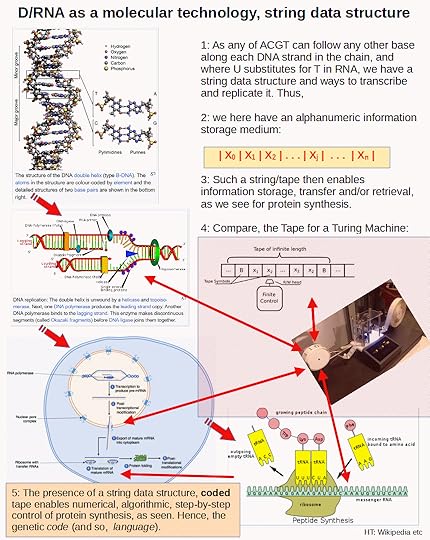
Where, of course, the genetic code is expressed in such strings. The (standard) code, mRNA form is:
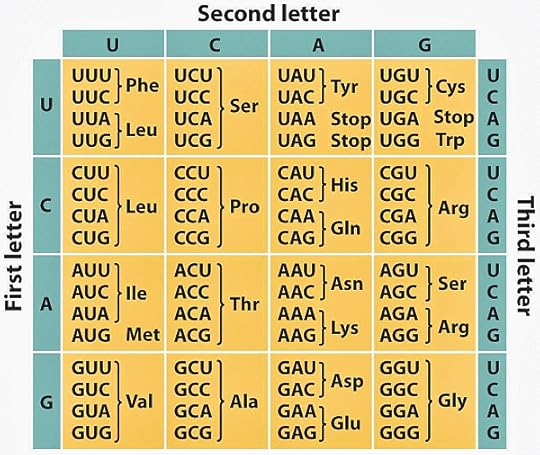 The Genetic code uses three-letter codons to specify the sequence of AA’s in proteins, specifying start/stop, and using six bits per AA
The Genetic code uses three-letter codons to specify the sequence of AA’s in proteins, specifying start/stop, and using six bits per AAFor very simple example, HT Khan Academy:
 The basic algorithmic process for protein synthesis [HT Khan, fair use edu]
The basic algorithmic process for protein synthesis [HT Khan, fair use edu]Of course, the above is the mRNA form, which would be transcribed and edited to cut out introns, and it leaves out onward complexities. For example, we can see how Insulin has two strands of AA’s interconnected through di-sulphide bonds, making up a 51 AA protein:
 The 51 aa, double chain protein, human insulin (fair use edu)
The 51 aa, double chain protein, human insulin (fair use edu)The end-product insulin protein is put together from the preproinsulin produced stepwise in the ribosome, by way of a clever alignment that uses a third, “scaffolding,” chain C sequence:
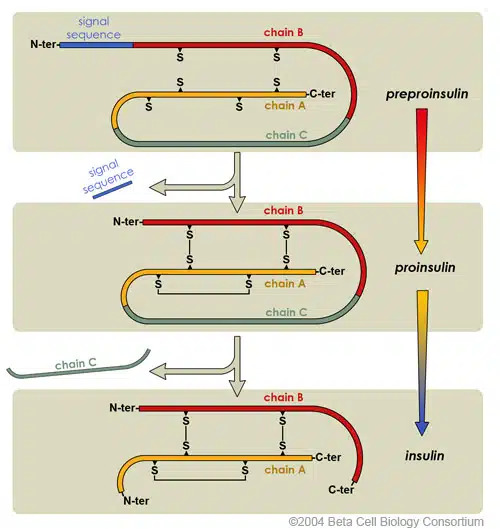 Assembling Insulin (fair use)
Assembling Insulin (fair use)Using the code one could in principle back-translate to mRNA, however, in the DNA there are intervening Introns between the Exons expressed in the ribosome, so the human genome sequence is:
 The underlying DNA sequence in the human genome (fair use)
The underlying DNA sequence in the human genome (fair use)So, as usual, we see how sophisticated life is at molecular level. That said, we also see that as a key stage of protein synthesis, as ribosomes, mRNA and tRNA interact (with a complex cast of supporting molecules) AA chains are assembled with start, elongate, stop, executing a code driven algorithm. Where, AmHD defines:
[Algorithm:] A finite set of unambiguous instructions that, given some set of initial conditions, can be performed in a prescribed sequence to achieve a certain goal and that has a recognizable set of end conditions.
Illustrating:
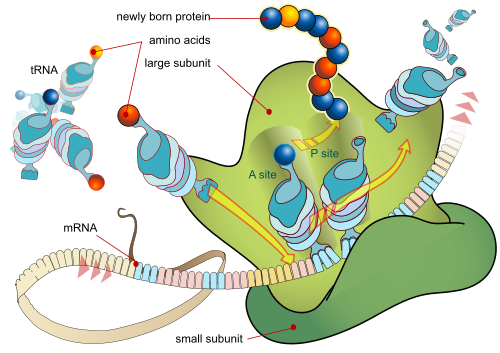 Step by step protein synthesis in action, in the ribosome, based on the sequence of codes in the mRNA control tape (Courtesy, Wikipedia and LadyofHats)
Step by step protein synthesis in action, in the ribosome, based on the sequence of codes in the mRNA control tape (Courtesy, Wikipedia and LadyofHats)That should be enough to show the unbiased mind that coded algorithms are in the cell, and that DNA and mRNA act as string data structures. However, there are those who have proved resistant to such commonplace summaries or to citations from the sort of panels of experts who write major textbooks in biochemistry. For record, notwithstanding, here are Lehninger and heirs:
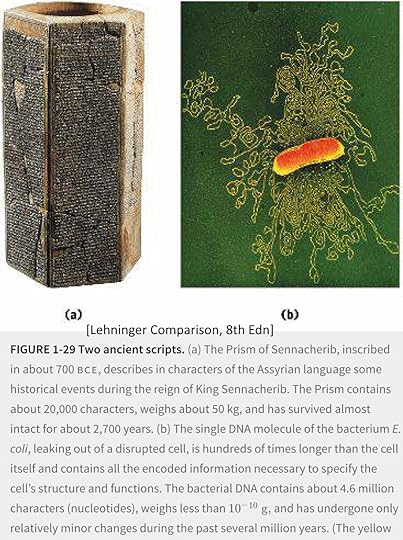 A page capture from Lehninger and heirs, Principles of Biochemistry, (fair use)
A page capture from Lehninger and heirs, Principles of Biochemistry, (fair use)Lehninger and heirs go on to say, pp. 194 – 5:
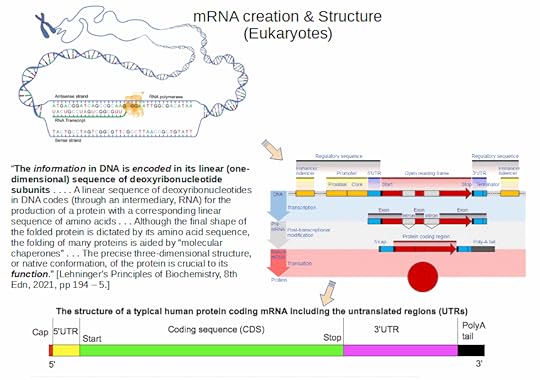 Augmented citation from Lehninger and heirs, on mRNA in protein synthesis (fair use)
Augmented citation from Lehninger and heirs, on mRNA in protein synthesis (fair use)We may also now observe a Nobel Prize Laureate, Sydney Brenner, in his article, Life’s code script . . . yes, it’s that obvious, published in 2012 in the leading Science Journal, Nature:
[Brenner:] ” . . . The most interesting connection with biology, in my view, is in Turing’s most important paper: ‘On computable numbers with an application to the Entscheidungsproblem’5, published in 1936, when Turing was just 24.
Computable numbers are defined as those whose decimals are calculable by finite means. [–> that is, effectively, by algorithms] Turing introduced what became known as the Turing machine to formalize the computation. The abstract machine is provided with a tape [–> with marks on it], which it scans one square at a time, and it can write, erase or omit symbols. The scanner may alter its mechanical state, and it can ‘remember’ previously read symbols. Essentially, the system is a set of instructions written on the tape, which describes the machine. Turing also defined a universal Turing machine, which can carry out any computation for which an instruction set can be written — this is the origin of the digital computer. [–> there is also, a more powerful oracle machine, capable of one step decisions]
Turing’s ideas were carried further in the 1940s by mathematician and engineer John von Neumann, who conceived of a ‘constructor’ machine capable of assembling another according to a description. A universal constructor with its own description would build a machine like itself. To complete the task, the universal constructor needs to copy its description and insert the copy into the offspring machine. Von Neumann noted that if the copying machine made errors, these ‘mutations’ would provide inheritable changes in the progeny.
Arguably the best examples of Turing’s and von Neumann’s machines are to be found in biology. Nowhere else are there such complicated systems, in which every organism contains an internal description of itself. The concept of the gene as a symbolic representation of the organism — a code script — is a fundamental feature of the living world and must form the kernel of biological theory. [–> note, again, author, context and publisher]
Turing died in 1954, one year after the discovery of the double-helical structure of DNA by James Watson and Francis Crick, but before biology’s subsequent revolution. Neither he nor von Neumann had any direct effect on molecular biology, but their work allows us to discipline our thoughts about machines, both natural and artificial.
Turing invented the stored-program computer, and von Neumann showed that the description is separate from the universal constructor. [–> that ‘description’ of course is encoded] This is not trivial. Physicist Erwin Schrödinger confused the program and the constructor in his 1944 book What is Life?, in which he saw chromosomes as “architect’s plan and builder’s craft in one”. This is wrong. The code script contains only a description of the executive function, not the function itself.
That’s why Yockey adapted Shannon’s architectural diagram for communication systems:
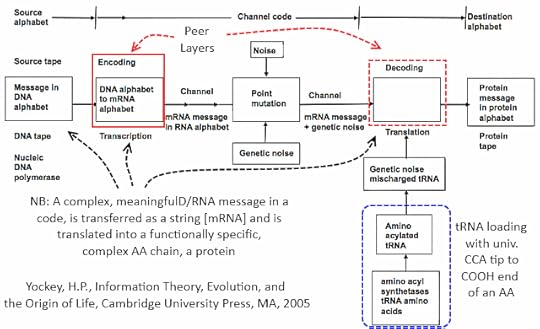 Yockey’s analysis of protein synthesis as a code-based communication process
Yockey’s analysis of protein synthesis as a code-based communication processSo, we may freely understand that DNA and associated molecules such as mRNA express string data structures, store coded biological information, that such information as used in protein synthesis expresses algorithms, and that therefore we are dealing with computation and associated computer language in the course of protein synthesis.
We may quote a Wiki confession:
[Wiki confesses:] Since 2001, 40 non-natural amino acids have been added into proteins by creating a unique codon (recoding) and a corresponding transfer-RNA:aminoacyl – tRNA-synthetase pair to encode it with diverse physicochemical and biological properties in order to be used as a tool to exploring protein structure and function or to create novel or enhanced proteins.[22][23]
H. Murakami and M. Sisido extended some codons to have four and five bases. Steven A. Benner [–>another guy] constructed a functional 65th (in vivo) codon.[24]
In 2015 N. Budisa, D. Söll and co-workers reported the full substitution of all 20,899 tryptophan residues (UGG codons) with unnatural thienopyrrole-alanine in the genetic code of the bacterium Escherichia coli.[25]
In 2016 the first stable semisynthetic organism was created. It was a (single cell) bacterium with two synthetic bases (called X and Y). The bases survived cell division.[26][27]
In 2017, researchers in South Korea reported that they had engineered a mouse with an extended genetic code that can produce proteins with unnatural amino acids.[28]
In May 2019, researchers reported the creation of a new “Syn61” strain of the bacterium Escherichia coli. This strain has a fully synthetic genome that is refactored (all overlaps expanded), recoded (removing the use of three out of 64 codons completely), and further modified to remove the now unnecessary tRNAs and release factors. It is fully viable and grows 1.6× slower than its wild-type counterpart “MDS42”
Indeed, the function of DNA as an information storage entity is so well established, that as Wiki also confesses, it has been adapted to general archival storage:
DNA digital data storage is the process of encoding and decoding binary data to and from synthesized strands of DNA.[1][2]
While DNA as a storage medium has enormous potential because of its high storage density, its practical use is currently severely limited because of its high cost and very slow read and write times.[3]
In June 2019, scientists reported that all 16 GB of text from Wikipedia’s English-language version had been encoded into synthetic DNA.[4] In 2021, scientists reported that a custom DNA data writer had been developed that was capable of writing data into DNA at 18 Mbps.[5]
Encoding methods
Countless methods for encoding data in DNA are possible. The optimal methods are those that make economical use of DNA and protect against errors.[6] If the message DNA is intended to be stored for a long period of time, for example, 1,000 years [–> a lot longer than most of our digital storage media will likely last], it is also helpful if the sequence is obviously artificial and the reading frame is easy to identify.[6]
CNet gives details:
the next storage technology might use an approach as old as life on earth: DNA. Startup Catalog announced Friday it’s crammed all of the text of Wikipedia’s English-language version onto the same genetic molecules our own bodies use.
It accomplished the feat with its first DNA writer, a machine that would fit easily in your house if you first got rid of your refrigerator, oven and some counter space. And although it’s not likely to push aside your phone’s flash memory chips anytime soon, the company believes it’s useful already to some customers who need to archive data.
DNA strands are tiny and tricky to manage, but the biological molecules can store other data than the genes that govern how a cell becomes a pea plant or chimpanzee. Catalog uses prefabricated synthetic DNA strands that are shorter than human DNA, but uses a lot more of them so it can store much more data.
Relying on DNA instead of the latest high-tech miniaturization might sound like a step backward. But DNA is compact, chemically stable — and given that it’s the foundation of the Earth’s biology, it’s arguably not as likely to become as obsolete as the spinning magnetized platters of hard drives or CDs that are disappearing today . . .
In short, they used a different encoding and have stored Wikipedia in DNA.
At this point, we need to ask, why is it that we have seen certain objectors from the penumbra of attack sites making strident, unyielding objections to understanding DNA and mRNA as string data structure information storage entities, part of a wider information processing, protein synthesis process in the cell?
The manifest answer is simple and sad: because such things point to design, which is being ideologically locked out at all costs.
So, it is time to recognise a key first fact about DNA and mRNA and let the chips lie where they fly. END
Copyright © 2023 Uncommon Descent . This Feed is for personal non-commercial use only. If you are not reading this material in your news aggregator, the site you are looking at is guilty of copyright infringement UNLESS EXPLICIT PERMISSION OTHERWISE HAS BEEN GIVEN. Please contact legal@uncommondescent.com so we can take legal action immediately.Plugin by Taragana
March 14, 2023
Jerry Coyne defends the sex binary in animals
Gotta hand it to Darwinian evolutionary biologist Jerry Coyne, he’s a brave one. He is taking on the Woke claim that sex isn’t really binary in animals:
It is a constant uphill battle for biologists to keep defending the truth that animals have but two sexes, defined by whether they have the reproductive apparatus to produce small, mobile gametes (the males) or large immobile gametes (the females). I’m not going to go into this again as you can read my explanation here. I have a longer and more popular explanation coming out in a big paper in June (stay tuned).
There are just two sexes in animals (and in nearly all vascular plants): male and female. Clownfish are not a third sex (they change from male to female.) Seahorse males are not a third sex (they are males who produce sperm and carry the fertilized eggs of females around in a pouch). Hermaphrodites are not a third sex (they combine aspects of male and female sex), and I’m aware of only one case in which a human hermaphrodite, whose male parts produced sperm, fathered an offspring. Hermaphroditic plants are not a third sex; they are simply hermaphrodites that contain male tissue and female tissue (producing small sperm and big eggs, respectively). There is no individual in animals or vascular plants that produce a third type of gamete. Ergo, sex is binary. – Jerry Coyne (March 8, 2023)
According to Colin Wright at City Journal, the Woke are on the march in science on this topic:
In pursuit of this goal, a “Multimodal Sex literature survey team” composed of researchers from UC–Berkeley and Loyola University Chicago has been assembled to “re-imagine a more inclusive framework for biological sex.” On January 27, 2023, the team produced their first pre-print paper, titled “Multimodal models of animal sex: breaking binaries leads to a better understanding of ecology and evolution.” The paper argues that sex is best viewed as “a constructed category operating at multiple biological levels” rather than bimodal or binary.
In saner times, such a paper would perhaps bring a small chuckle from a journal editor before issuing a swift rejection. But current times are far from sane, and the quick ascendance of fashionable pseudoscience in academia on the biology of sex is ample reason to worry that this paper will not receive the withering review it deserves. (March 2, 2023)
It will probably receive accolades from science bureaucrats. Sanity was cancelled some time ago anyhow.
Copyright © 2023 Uncommon Descent . This Feed is for personal non-commercial use only. If you are not reading this material in your news aggregator, the site you are looking at is guilty of copyright infringement UNLESS EXPLICIT PERMISSION OTHERWISE HAS BEEN GIVEN. Please contact legal@uncommondescent.com so we can take legal action immediately.Plugin by Taragana
At Evolution News: Evolution’s Tall Tale — The Giraffe Neck
Often portrayed as a simple Darwinian development, it was recently admitted at Nature to be a puzzle:
The giraffe’s neck has long been a beloved icon of evolutionary theory. According to the story, one of the giraffe’s short-necked ancestors had a slightly longer neck, which helped him reach leaves the other animals on the savannah couldn’t. This gave him a survival advantage he passed on to his offspring. Or maybe the female giraffes really dug his slightly longer neck, giving him a reproductive advantage. Same result. He passed his slightly longer neck on to his offspring. Rinse and repeat a few thousand times, and voila, the lineage ends up with 600-pound, six-foot long giraffe necks. – Jonathan Witt (March 13, 2023)
From Nature:
One prevailing theory is that giraffes evolved longer necks to reach higher trees for food. “This is widely believed; it’s really entrenched,” says Simmons…. [But] research has shown that giraffes tend to eat from lower levels, and tall giraffes aren’t more likely to survive drought, when food competition is highest. Another idea is that giraffes evolved longer necks for sexual competition, with male giraffes engaging in violent neck-swinging fights and longer necks attracting mates…. [But] males don’t have longer necks than females.” – Nicola Jones, “How the Giraffe Got Its Neck,” Nature, June 2, 2022, internal references removed. For additional evidence against the “necks for sex” hypothesis, see Byriley Black, “Giraffe Necks Not for Sex,” National Geographic, January 15, 2013.
Much more at the link.
Copyright © 2023 Uncommon Descent . This Feed is for personal non-commercial use only. If you are not reading this material in your news aggregator, the site you are looking at is guilty of copyright infringement UNLESS EXPLICIT PERMISSION OTHERWISE HAS BEEN GIVEN. Please contact legal@uncommondescent.com so we can take legal action immediately.Plugin by Taragana
Michael J. Behe's Blog
- Michael J. Behe's profile
- 219 followers



